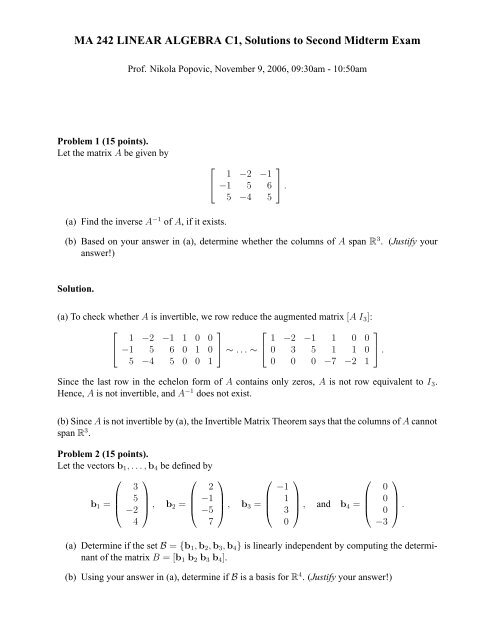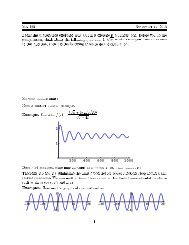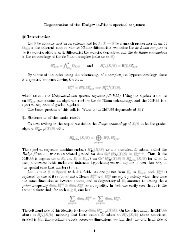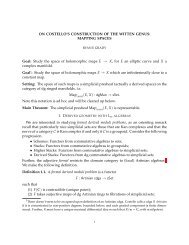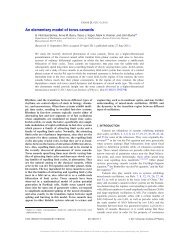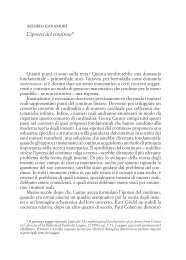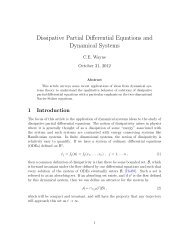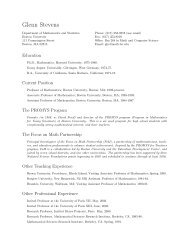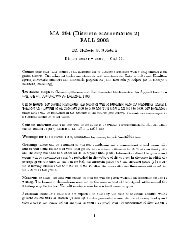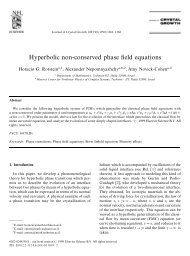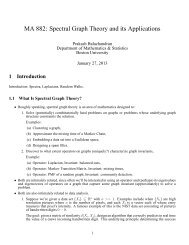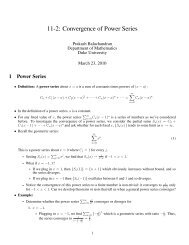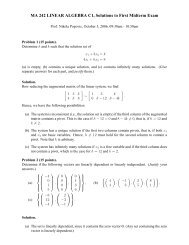MA 242 LINEAR ALGEBRA C1, Solutions to Second Midterm Exam
MA 242 LINEAR ALGEBRA C1, Solutions to Second Midterm Exam
MA 242 LINEAR ALGEBRA C1, Solutions to Second Midterm Exam
Create successful ePaper yourself
Turn your PDF publications into a flip-book with our unique Google optimized e-Paper software.
<strong>MA</strong> <strong>242</strong> <strong>LINEAR</strong> <strong>ALGEBRA</strong> <strong>C1</strong>, <strong>Solutions</strong> <strong>to</strong> <strong>Second</strong> <strong>Midterm</strong> <strong>Exam</strong><br />
Problem 1 (15 points).<br />
Let the matrix A be given by<br />
Prof. Nikola Popovic, November 9, 2006, 09:30am - 10:50am<br />
(a) Find the inverse A −1 of A, if it exists.<br />
⎡<br />
⎣<br />
1 −2 −1<br />
−1 5 6<br />
5 −4 5<br />
(b) Based on your answer in (a), determine whether the columns of A span R 3 . (Justify your<br />
answer!)<br />
Solution.<br />
(a) To check whether A is invertible, we row reduce the augmented matrix [A I3]:<br />
⎡<br />
1 −2 −1 1 0<br />
⎤<br />
0<br />
⎡<br />
1 −2 −1 1 0<br />
⎤<br />
0<br />
⎣ −1 5 6 0 1 0 ⎦ ∼ . . . ∼ ⎣ 0 3 5 1 1 0 ⎦ .<br />
5 −4 5 0 0 1<br />
0 0 0 −7 −2 1<br />
Since the last row in the echelon form of A contains only zeros, A is not row equivalent <strong>to</strong> I3.<br />
Hence, A is not invertible, and A −1 does not exist.<br />
(b) Since A is not invertible by (a), the Invertible Matrix Theorem says that the columns of A cannot<br />
span R 3 .<br />
Problem 2 (15 points).<br />
Let the vec<strong>to</strong>rs b1, . . . , b4 be defined by<br />
⎛ ⎞<br />
3<br />
⎜<br />
b1 = ⎜ 5 ⎟<br />
⎝ −2 ⎠<br />
4<br />
, b2<br />
⎛ ⎞<br />
2<br />
⎜<br />
= ⎜ −1 ⎟<br />
⎝ −5 ⎠<br />
7<br />
, b3<br />
⎛<br />
⎜<br />
= ⎜<br />
⎝<br />
⎤<br />
⎦ .<br />
−1<br />
1<br />
3<br />
0<br />
⎞<br />
⎟<br />
⎠ , and b4 =<br />
(a) Determine if the set B = {b1, b2, b3, b4} is linearly independent by computing the determinant<br />
of the matrix B = [b1 b2 b3 b4].<br />
(b) Using your answer in (a), determine if B is a basis for R 4 . (Justify your answer!)<br />
⎛<br />
⎜<br />
⎝<br />
0<br />
0<br />
0<br />
−3<br />
⎞<br />
⎟<br />
⎠ .
Solution.<br />
(a) The determinant of B is most easily computed by first going down the fourth column,<br />
⎡<br />
3<br />
⎢<br />
detB = det ⎢ 5<br />
⎣ −2<br />
4<br />
2<br />
−1<br />
−5<br />
7<br />
−1<br />
1<br />
3<br />
0<br />
⎤<br />
0<br />
0 ⎥<br />
0 ⎦<br />
−3<br />
= (−1)4+4 ⎡<br />
3<br />
(−3) det ⎣ 5<br />
−2<br />
<br />
2<br />
−1<br />
−5<br />
<br />
⎤<br />
−1<br />
1 ⎦ .<br />
3<br />
<br />
Now, one possibility <strong>to</strong> compute the determinant of the 3 × 3-submatrix B44 is<br />
Hence, detB = (−3)(−1) = 3.<br />
detB44 = (3)(−1)(3) + (2)(1)(−2) + (−1)(5)(−5)<br />
B44<br />
− [(−2)(−1)(−1) + (−5)(1)(3) + (3)(5)(2)] = −1.<br />
(b) Since detB = 0, it follows that the matrix B is invertible. Hence, by the Invertible Matrix<br />
Theorem, the columns of B are linearly independent, and the columns of B span R 4 . Therefore,<br />
the set B is a basis for R 4 .<br />
Problem 3 (15 points).<br />
Let the matrix A be given by<br />
⎡<br />
⎣<br />
−3 6 −1 1 −7<br />
1 −2 2 3 −1<br />
2 −4 5 8 −4<br />
(a) Find a basis for the column space ColA of A.<br />
(b) Find a basis for the null space NulA of A.<br />
(c) What are the dimensions of ColA and NulA? (Justify your answers!)<br />
Solution.<br />
(a) To find a basis for ColA, we have <strong>to</strong> reduce A <strong>to</strong> echelon form:<br />
⎡<br />
−3 6 −1 1<br />
⎤<br />
−7<br />
⎡<br />
1 −2 2 3 −1<br />
⎣ 1 −2 2 3 −1 ⎦ ∼ . . . ∼ ⎣ 0 0 1 2 −2<br />
2 −4 5 8 −4<br />
0 0 0 0 0<br />
The pivot columns in the echelon form are the first and third columns; therefore, a basis for ColA<br />
is given by the first and third columns of A, (−3, 1, 2) and (−1, 2, 5).<br />
(b) To obtain a basis for NulA, we have <strong>to</strong> find the solution set of Ax = 0. Hence, we continue row<br />
reducing until the reduced echelon form of A is found:<br />
⎡<br />
1 −2 2 3<br />
⎤<br />
−1<br />
⎡<br />
1 −2 0 −1<br />
⎤<br />
3<br />
⎣ 0 0 1 2 −2 ⎦ ∼ ⎣ 0 0 1 2 −2 ⎦ .<br />
0 0 0 0 0 0 0 0 0 0<br />
⎤<br />
⎦ .<br />
⎤<br />
⎦ .
The basic variables x1 and x3 can be expressed in terms of the free variables x2, x4, and x5, with<br />
x1 = 2x2 + x4 − 3x5 and x3 = −2x4 + 2x5. The general solution in parametric vec<strong>to</strong>r form is<br />
given by<br />
⎛<br />
⎜<br />
x = ⎜<br />
⎝<br />
x1<br />
x2<br />
x3<br />
x4<br />
x5<br />
⎞<br />
⎟<br />
⎠<br />
= x2<br />
⎛<br />
⎜<br />
⎝<br />
2<br />
1<br />
0<br />
0<br />
0<br />
⎞<br />
⎟<br />
⎠<br />
+ x4<br />
Hence, a basis for NulA is given by the three vec<strong>to</strong>rs (2, 1, 0, 0, 0), (1, 0, −2, 1, 0), and (−3, 0, 2, 0, 1).<br />
(c) Since the basis for ColA found in (a) consists of two vec<strong>to</strong>rs, the dimension of ColA is 2. Since<br />
the basis for NulA found in (b) consists of three vec<strong>to</strong>rs, the dimension of NulA is 3.<br />
(Note: This agrees with the Rank Theorem, since dim(ColA)+dim(NulA)= 5 equals the number of<br />
columns of A.)<br />
Problem 4 (15 points).<br />
Let V be a vec<strong>to</strong>r space, and let B = {b1, . . . , bn} be a basis for V . Show that the coordinate<br />
mapping x ↦→ [x]B is an isomorphism from V on<strong>to</strong> R n .<br />
Solution.<br />
To show that the coordinate mapping is an isomorphism, we have <strong>to</strong> show that it is linear, one-<strong>to</strong>one,<br />
and on<strong>to</strong>. For vec<strong>to</strong>rs x and y in V , let x = c1b1+. . .+cnbn and y = d1b1+. . .+dnbn. Then,<br />
[x]B = (c1, . . . , cn) and [y]B = (d1, . . . , dn). Moreover, x + y = (c1 + d1)b1 + . . . + (cn + bn)bn,<br />
and<br />
⎛<br />
⎜<br />
⎝<br />
1<br />
0<br />
−2<br />
1<br />
0<br />
⎞<br />
⎟<br />
⎠<br />
+ x5<br />
⎛<br />
⎜<br />
⎝<br />
−3<br />
0<br />
2<br />
0<br />
1<br />
⎞<br />
⎟<br />
⎠ .<br />
[x + y]B = (c1 + d1, . . . , cn + dn) = (c1, . . . , cn) + (d1, . . . , dn)<br />
= [x]B + [y]B.<br />
Also, cx = (cc1)b1 + . . . + (ccn)bn, and<br />
[cx]B = (cc1, . . . , ccn) = c(c1, . . . , cn)<br />
= c[x]B,<br />
and the coordinate mapping is therefore linear. To show that it is one-<strong>to</strong>-one, assume that [x]B =<br />
(c1, . . . , cn) = [y]B for two vec<strong>to</strong>rs x and y in V . Then,<br />
x = c1b1 + . . . + cnbn and y = c1b1 + . . . + cnbn,<br />
so x = y, which proves one-<strong>to</strong>-one-ness. To show that the coordinate mapping is on<strong>to</strong>, let<br />
(c1, . . . , cn) be a vec<strong>to</strong>r in R n . Then, (c1, . . . , cn) is the image of the vec<strong>to</strong>r x = c1b1 + . . . + cnbn<br />
in V , that is, [x]B = (c1, . . . , cn), which proves on<strong>to</strong>-ness.<br />
(Note: To prove that V and R n are isomorphic for general vec<strong>to</strong>r spaces V , you cannot use the<br />
change-of-coordinates matrix PB = [b1 . . . bn]. This matrix is only defined if V = R n , that is, if<br />
the vec<strong>to</strong>rs b1, . . . , bn are vec<strong>to</strong>rs in R n that can be written in<strong>to</strong> a matrix!)
Problem 5 (20 points).<br />
Let P denote the vec<strong>to</strong>r space of all polynomials, and let P2 be the set of all polynomials of degree<br />
at most 2; that is, P2 = {p(t) : p(t) = a0 + a1t + a2t 2 , a0, a1, a2 real}.<br />
(a) Show that P2 is a subspace of P.<br />
(b) Using coordinate vec<strong>to</strong>rs, show that the set B given by<br />
is a basis for P2.<br />
B = {1 + t 2 , 2 − t + 3t 2 , 1 + 2t − 4t 2 }<br />
(c) Find the coordinate vec<strong>to</strong>r [p]B of the polynomial p(t) = −4 − t 2 relative <strong>to</strong> B.<br />
(d) Find the polynomial q(t) whose coordinate vec<strong>to</strong>r relative <strong>to</strong> B is [q]B = (−3, 1, 2).<br />
Solution.<br />
(a) Since the zero polynomial p = 0 is obtained for a0 = a1 = a2 = 0, P2 contains the zero vec<strong>to</strong>r<br />
of P. Given two polynomials p(t) = a0 + a1t + a2t 2 and q(t) = b0 + b1t + b2t 2 in P2, the sum<br />
(p + q)(t) = (a0 + b0) + (a1 + b1)t + (a2 + b2)t 2<br />
is in P2. Hence, P2 is closed under vec<strong>to</strong>r addition. Also, for any scalar c,<br />
(cp)(t) = (ca0) + (ca1)t + (ca2)t 2<br />
is in P2, and P2 is closed under scalar multiplication. So, in sum, P2 is a subspace of P.<br />
(b) The coordinate vec<strong>to</strong>rs of the polynomials 1 + t 2 , 2 − t + 3t 2 , and 1 + 2t − 4t 2 are (1, 0, 1),<br />
(2, −1, 3), and (1, 2, −4), respectively. (The entries in the coordinate vec<strong>to</strong>rs contain the coefficients<br />
of 1, t, and t 2 , respectively.) Since the matrix formed from these vec<strong>to</strong>rs is row equivalent <strong>to</strong> the<br />
identity matrix I3,<br />
⎡<br />
⎣<br />
1 2 1<br />
0 −1 2<br />
1 3 −4<br />
⎤<br />
⎡<br />
⎦ ∼ . . . ∼ ⎣<br />
1 2 1<br />
0 1 −2<br />
0 0 −3<br />
⎤<br />
⎦ ∼ . . . ∼ I3,<br />
the coordinate vec<strong>to</strong>rs are linearly independent and span R 3 . By the isomorphism between P2 and<br />
R 3 , the corresponding polynomials 1 + t 2 , 2 − t + 3t 2 , and 1 + 2t − 4t 2 are linearly independent<br />
and span P2. Therefore, they form a basis for P2.<br />
(c) To find [p]B, we have <strong>to</strong> determine how p(t) = −4 − t2 = (−4)1 + (0)t + (−1)t2 can be<br />
combined from the polynomials in B. This can be done by solving the linear system obtained from<br />
the corresponding coordinate vec<strong>to</strong>rs:<br />
⎡<br />
⎣<br />
1 2 1 −4<br />
0 −1 2 0<br />
1 3 −4 −1<br />
⎤<br />
⎡<br />
⎦ ∼ . . . ∼ ⎣<br />
1 0 0 1<br />
0 1 0 −2<br />
0 0 1 −1<br />
⎤<br />
⎦ .
Hence, [p]B = (1, −2, 1).<br />
(d) To find the polynomial q corresponding <strong>to</strong> [q]B = (−3, 1, 2), we just compute the matrix-vec<strong>to</strong>r<br />
product<br />
⎡<br />
1 2<br />
⎤ ⎛ ⎞<br />
1 −3<br />
⎛ ⎞<br />
1<br />
⎣ 0 −1 2 ⎦ ⎝ 1 ⎠ = ⎝ 3 ⎠ .<br />
1 3 −4 2 −8<br />
Therefore, q(t) = 1 + 3t − 8t 2 .<br />
Problem 6 (20 points).<br />
Determine whether the statements below are true or false. (Justify your answers: If a statement<br />
is true, explain why it is true; if it is false, explain why, or give a counter-example for which it is<br />
false.)<br />
(a) If A and B are m × n-matrices, then both AB T and A T B are defined.<br />
(b) The determinant of an n × n-matrix A is the product of the diagonal entries in A.<br />
(c) For A an m × n-matrix, ColA is the set of all solutions of the linear system Ax = b.<br />
(d) For x in R n , the coordinate vec<strong>to</strong>r [x]E of x relative <strong>to</strong> the standard basis E is x itself.<br />
Solution.<br />
(a) True. For A and B m × n, A T and B T are n × m, so both matrix products AB T and A T B are<br />
defined: The number of columns of A, n, equals the number of rows of B T ; the number of columns<br />
of A T , m, equals the number of rows of B.<br />
(b) False; this statement is only true if A is a triangular matrix. Take e.g.<br />
A =<br />
1 2<br />
1 0<br />
then, detA = (1)(0) − (1)(2) = −2, whereas the product of the diagonal elements is 0.<br />
(c) False. The column space ColA is the set of all linear combinations of the columns of A, that is,<br />
<br />
;<br />
ColA = {b in R m : Ax = b for some x in R n }.<br />
The solution set of Ax = b would be the set of all x in R n such that Ax = b!<br />
(d) True. In general, the coordinate vec<strong>to</strong>r of x in R n relative <strong>to</strong> a basis B is related <strong>to</strong> x by<br />
PB[x]B = x. For B = E, the change-of-coordinates matrix PE is the identity matrix In. Hence,<br />
x = In[x]E = [x]E.


